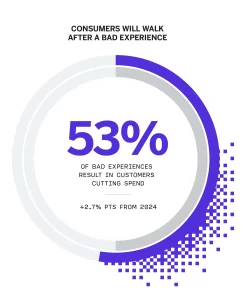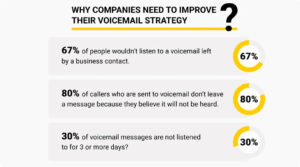Voicemail drops have become a significant tool for businesses looking to engage with customers efficiently and effectively. Unlike traditional phone calls, voicemail drops allow businesses to send pre-recorded messages directly to a recipient’s voicemail without them having to pick up the phone. This method not only saves time but also allows for a strategic approach to customer engagement. As technology advances, so do the capabilities of voicemail drop services. We’ll explore the future of voicemail drops and the key trends and innovations businesses should watch for.
1. Integration with Advanced CRM Systems
One of the biggest innovations on the horizon is the integration of voicemail drops with advanced customer relationship management (CRM) systems. This seamless connection will enable businesses to personalize messages based on a customer’s history, preferences, and interactions with the brand. By pulling data from a CRM, businesses can create highly targeted voicemail messages that are more likely to resonate with the listener.
Imagine being able to send a tailored voicemail drop that mentions a recent purchase or a customer support interaction. Such personalization not only enhances the customer experience but also strengthens brand loyalty. This level of integration will help businesses automate their communication while maintaining a personal touch.
2. Use of Artificial Intelligence (AI) for Personalization
AI-driven technology is transforming how businesses approach voicemail drops. Future innovations will include the use of AI to dynamically craft personalized messages based on real-time data and customer profiles. This means that voicemail drops will no longer be limited to pre-recorded messages but will evolve into adaptive scripts that adjust content according to the recipient’s behavior and preferences.
AI will also play a role in optimizing the timing of voicemail drops. By analyzing data such as past interactions and customer engagement patterns, AI can determine the optimal time to send a voicemail to maximize open rates and responses. This level of sophistication will make voicemail campaigns more effective and improve ROI.

3. Enhanced Analytics and Reporting Capabilities
The future of voicemail drops will see a significant shift in how data is collected, analyzed, and used. Enhanced analytics and reporting capabilities will provide businesses with deeper insights into their voicemail campaigns’ performance. Metrics like listen rates, response rates, and customer sentiment analysis will enable marketers to assess the effectiveness of their voicemail messages more accurately.
Advanced reporting tools will allow businesses to segment their audience based on different parameters such as demographics, engagement history, and past interactions. By understanding which segments respond best to voicemail drops, companies can refine their approach and tailor messages for maximum impact. This data-driven approach will be crucial for optimizing voicemail strategies and achieving better marketing outcomes.
4. Interactive Voicemail Drops
Interactive voicemail drops are a trend that is set to change the way businesses engage with customers. Unlike traditional voicemail drops, interactive messages offer recipients the opportunity to respond via voice commands or text prompts. This feature can create a more engaging experience and provide a unique touchpoint for customer interaction.
For example, a voicemail drop could include an invitation to press a button to schedule an appointment or reply with a keyword to access exclusive offers. These interactive elements can significantly improve user engagement and create a seamless path for customers to take action. This move toward more interactive communication aligns with the growing emphasis on user-centric marketing strategies.

5. Integration with Other Marketing Channels
Voicemail drops are increasingly being integrated with other digital marketing channels, creating a cohesive and multi-channel approach to customer outreach. By combining voicemail drops with SMS, email marketing, and social media campaigns, businesses can create a more comprehensive strategy that engages customers across various platforms.
For instance, a business could send a voicemail drop to inform a customer of an upcoming promotion, followed by an SMS reminder or an email with more details and a direct link to a landing page. This integrated approach helps reinforce the message and increases the chances of customer engagement.
6. Compliance and Privacy Enhancements
As the use of voicemail drops becomes more widespread, privacy and compliance will become major considerations. Regulations such as the Telephone Consumer Protection Act (TCPA) and various data privacy laws require businesses to be transparent about their communication practices and obtain proper consent before sending messages.
The future of voicemail drops will see innovations aimed at ensuring compliance and respecting consumer privacy. This includes automated systems that track consent and opt-in preferences, as well as technology that allows consumers to easily opt-out of receiving messages. Businesses that prioritize compliance and data protection will not only build trust with their customers but also avoid potential legal issues.

7. Voice Cloning and Synthetic Speech
Another exciting development in the future of voicemail drops is the use of voice cloning and synthetic speech technology. With advancements in AI, businesses will be able to create voicemail messages using synthetic voices that closely mimic real human speech. This means that businesses can produce high-quality, personalized voicemail messages without needing to record each one individually.
Voice cloning technology can be used to create consistent messaging across campaigns and ensure that each voicemail maintains the brand’s tone and voice. This technology will enable businesses to scale their voicemail campaigns more efficiently, producing high-quality messages at a lower cost and with reduced production time.
8. Geo-Targeted Voicemail Drops
Location-based marketing is a growing trend, and voicemail drops are poised to benefit from this development. Geo-targeted voicemail drops allow businesses to send messages based on the recipient’s geographic location, ensuring that the content is relevant to their specific area. This can be particularly beneficial for businesses with multiple locations or those running region-specific promotions.
For instance, a local retail store could send voicemail drops to customers in their area about a flash sale or special event. By leveraging geo-targeting, businesses can make their voicemail campaigns more relevant and increase the chances of customer engagement and action.
9. Voicemail Drops for Customer Feedback and Surveys
Voicemail drops are not just for promotional or informative purposes; they can also be an effective way to gather customer feedback. Future innovations will see voicemail drops being used as a tool for conducting short surveys or requesting feedback after a purchase or interaction.
By integrating a call-to-action that prompts customers to call back or leave feedback, businesses can use voicemail drops to collect valuable insights and improve their products and services. This customer-centric approach can help businesses fine-tune their strategies and better meet the needs of their audience.

10. A/B Testing and Experimentation
The use of A/B testing in voicemail campaigns will become more prevalent as businesses strive to fine-tune their messaging. A/B testing involves creating two or more variations of a voicemail message and sending them to different segments of the audience to determine which version performs better. With the help of advanced analytics, businesses can measure the effectiveness of different scripts, tones, and calls to action.
Future voicemail drop platforms will likely offer built-in A/B testing tools, allowing businesses to experiment with different types of messages and make data-driven decisions. This will lead to more effective campaigns that better resonate with customers and drive higher engagement rates.
11. Voicemail Drops for Customer Retention and Loyalty Programs
One of the growing applications of voicemail drops is for enhancing customer retention and supporting loyalty programs. Unlike one-off promotional messages, retention-focused voicemail drops can provide personalized updates, reminders for exclusive rewards, or notifications about upcoming loyalty program milestones. By reaching out directly to customers, businesses can reinforce the value of their loyalty programs and motivate repeat purchases.
For example, a company could send a voicemail drop to a customer reminding them of their accrued points or exclusive benefits that are available if they make a purchase soon. These targeted messages can increase engagement and reinforce a positive relationship between the brand and the customer, leading to higher retention rates and long-term loyalty.

12. Customizable Call-to-Action (CTA) Options
The effectiveness of a voicemail drop often comes down to the strength of its call-to-action (CTA). The future will see voicemail platforms offering more customizable and dynamic CTA options that allow businesses to tailor messages to their specific goals. Whether the desired action is directing the listener to a landing page, prompting them to call back, or scheduling an appointment, businesses will have the flexibility to craft CTAs that align with their objectives.
Interactive voicemail technology will also introduce more complex CTAs, such as offering the ability to respond via voice or SMS directly from the voicemail. This can make it easier for customers to take immediate action, resulting in a smoother user experience and a more responsive customer base.
13. Advanced Voice Metrics and Customer Sentiment Analysis
As voicemail technology advances, the ability to analyze customer responses and sentiment will become increasingly sophisticated. Future platforms will include advanced voice metrics that can identify the tone, emotion, and overall sentiment in a customer’s voice or response. This information can then be used to evaluate the effectiveness of voicemail campaigns and to tailor future messages more effectively.
For example, if a voicemail campaign receives a higher proportion of positive responses, it indicates that the tone and content of the message were well-received. Conversely, if negative or hesitant responses are prevalent, businesses can use this feedback to tweak their scripts, messaging, or delivery strategies. This form of real-time sentiment analysis can transform how businesses approach voicemail marketing and improve their understanding of customer preferences.
14. Voicemail Drop Platforms with Integrated Multi-Language Support
As businesses continue to expand into global markets, the need for multi-language support in voicemail campaigns will become more critical. Future voicemail platforms will likely integrate more comprehensive language options, making it easier for companies to communicate with customers in their preferred language. This inclusivity will foster stronger connections with customers from diverse linguistic backgrounds and expand market reach.
Voice translation and automated multi-language scripting will allow businesses to create voicemail drops that automatically adapt to the recipient’s language based on their location or preference. This will create a personalized experience that is inclusive and more likely to resonate with a broader audience.
15. Seamless Integration with Customer Service Teams
Future voicemail drop technologies will integrate more seamlessly with customer service operations, allowing for better coordination and response management. If a voicemail drop prompts a customer to take an action or ask a question, it can be integrated with customer service tools to streamline responses. For instance, if a voicemail drop prompts a customer to reply with a question, the interaction can trigger an automated reply or direct the customer to a live chat or support agent.
These integrations will ensure that customers receive prompt and helpful responses, increasing the likelihood that they will remain satisfied with the brand and more likely to continue engaging. Enhanced customer service response time and a more seamless experience will improve brand reputation and build trust with the customer base.
16. Optimized Voicemail Drops for E-commerce Businesses
Voicemail drops will become an essential tool for e-commerce businesses looking to enhance customer engagement and boost sales. The future will see more tailored voicemail strategies that cater specifically to e-commerce, from abandoned cart reminders to personalized post-purchase follow-ups. E-commerce companies can use voicemail drops to remind customers of items left in their carts or offer special promotions for items they have previously viewed.
Additionally, voicemail drops can be used to communicate shipping updates or delivery notifications, helping e-commerce businesses stay connected with customers throughout the purchasing process. The ability to keep customers informed can reduce anxiety and foster a sense of trust, ultimately enhancing the overall customer experience and encouraging repeat purchases.

17. Voice-Activated Reminders and Follow-Ups
As voice-activated technology becomes more mainstream, voicemail drops will be able to integrate with smart home devices and virtual assistants. This will open the door for follow-ups and reminders that are activated by voice commands. For instance, a customer could receive a voicemail drop about a special promotion and respond to it simply by saying a phrase like, “Remind me tomorrow,” or “Send me more details.”
This level of voice interactivity makes it possible for customers to engage with voicemail content in real time, opening up new pathways for customer convenience and direct interaction. Businesses that implement this feature will be able to capture more attention and encourage quicker responses to calls-to-action.
18. Enhanced Security Features for Voicemail Drops
As concerns around privacy and data security continue to rise, the future of voicemail drops will include more robust security measures. Advanced encryption protocols and data protection standards will become standard in voicemail platforms to safeguard customer information and ensure compliance with data privacy laws such as the GDPR and CCPA.
Additionally, businesses will need to ensure that customers have the ability to manage their preferences and opt out of voicemail drops easily. This transparent approach will help build trust and improve customer satisfaction, reinforcing a company’s commitment to data security and consumer rights.
19. Custom Voice Branding and Voice Recognition
To further strengthen brand identity, future voicemail drops will allow for custom voice branding. This means that businesses can create voicemail messages that are delivered in a voice that matches their brand’s personality, whether it’s warm and friendly, professional and authoritative, or fun and quirky. Voice recognition will allow businesses to adjust the content based on who is receiving the message, ensuring the message is as effective as possible.
For example, a company could use voice recognition technology to personalize the greeting or offer based on the recipient’s past interactions or preferences. This deeper layer of customization will make voicemail drops feel more authentic and aligned with the brand’s identity, making the customer more likely to engage and act on the message.
Embracing the Future of Voicemail Drops
The future of voicemail drops is full of exciting possibilities. With technological advancements in AI, voice integration, interactive elements, and enhanced personalization, businesses will be able to leverage voicemail drops in more powerful and innovative ways than ever before. Whether it’s through seamless integrations with CRM systems, dynamic voice metrics, or the ability to reach customers in multiple languages, these developments will help businesses build stronger connections, improve customer experiences, and drive better results.
Embracing these trends and innovations will be key for businesses that want to stay competitive and maximize the effectiveness of their voicemail marketing strategies. The power of voicemail drops is only just beginning, and those who are ahead of the curve will reap the rewards of this evolving communication tool.

